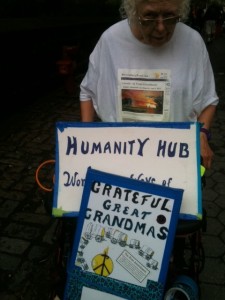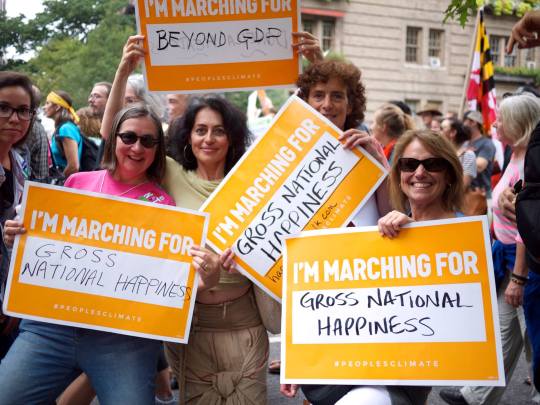The People’s Climate March: We Are the Ones We’ve Been Waiting For
As the threats of climate change increase, the relevance of this blog — published first in October 2014 at the HappinessParadigm.com — also increases.

Traveling to New York City for the People’s Climate March on September 21, 2014 was one of the best decisions I’ve ever made. Yes, it made me happy. Intensely, deeply, indescribably happy. I was absolutely in the right place at the right time — not only for myself, but for all life on our precious planet. I was overwhelmed with gratitude for everyone around me who made the effort to show up for this desperately needed wake-up call; pride that I was one of them; hope that maybe we can save the human race after all; and flat-out joy being in the presence of such a diverse, beautiful, celebratory crowd.
We are the ones we’ve been waiting for.
From a science of happiness standpoint, there’s no question why I would feel such a high — a transformative high, I believe — from this march. Pick your happiness researcher and theory, and I can pretty much check it off the list. Mihaly Czikszentmihalyi and flow, or having a peak experience? Ha! This was a lifetime peak experience! Tal Ben-Shahar and his teachings on living in concordance with our values? Yes, big time. Barbara Frederickson and the positivity ratio? My ratio of positive to negative experiences that day was off the charts. Chris Peterson and the theory of greater happiness by acting from our personal strengths? My signature strength is the ability to give and receive love, and this day was all about the love.
Then there’s Martin Seligman’s P.E.R.M.A. which I used to predict my happiness at this event in another essay last month. In reality, at the People’s Climate March, I was seeped in P.E.R.M.A.:
- Positivity — oh, yes, everywhere, all weekend, even in the long long bathroom lines.
- Engagement — fierce engagement, with the issues, with the future, with the city of New York, with the people all around me.
- Relationships — yes, with the friends new and old with whom I was marching, and with all the other marchers, too — we were all connected.
- Meaning — are you kidding me? Fighting for the future of the planet? It doesn’t get any more meaningful than that.
- And accomplishment? The organizers of this historic march hoped for 100,000 participants and four times that many showed up — 400,000 of us! We did it!
All of this and more shaped that momentous day. Now, back in my Vermont home, my heart and spirit are clinging to purpose, shared community, optimism, and mutual love for the planet and each other — a blend encapsulated by the most moving chant of the march, this piece of a prayer by a Hopi elder:
We are the ones we’ve been waiting for.
Oh my god, yes. We are! And, just to be clear, by “we,” I mean you, too — any and all of you who were at the march in body or spirit, or

will be at the next one, or are doing your best to fight climate change on your home turf. There is no one who can swoop in and magically fix this disastrous situation — literally disastrous, and likely to grow worse. As one sign put it, “To Change Everything, We Need Everyone.”
Sunday, it felt like everyone did indeed show up. For so long, I’ve been wondering when Americans were going to rise up, take to the streets, and demand environmental and economic justice. Finally, finally, we the people were out in glorious, loud, forceful numbers. Yes, there were some justifiably famous climate warriors near the front of the march — like Bill McKibben, Vandana Shiva, and our own beloved Senator Bernie Sanders. They weren’t at the very front, though, because that spot was reserved for the indigenous peoples and others in the United States and around the world who are already suffering from climate change. I felt humbled to be marching behind these front line warriors. We need them, and they need us.
We are the ones we’ve been waiting for.
The chant sent me back to re-read the Hopi prayer:
You have been telling the people that this is the Eleventh Hour. Now you must go back and tell the people that this is the Hour. And there are things to be considered. Where are you living? What are you doing?
What are your relationships?
Are you in right relation?
Where is your water?
Know your garden.
It is time to speak your Truth.
Create your community.
Be good to each other.
And do not look outside yourself for the leader.
This could be a good time!
There is a river flowing now very fast.
It is so great and swift that there are those who will be afraid.
They will try to hold on to the shore.
They will feel they are torn apart and will suffer greatly.
Know the river has its destination.
The elders say we must let go of the shore, push off into the middle of the river, keep our eyes open, and our heads above water.
And I say, see who is in there with you and celebrate.
At this time in history, we are to take nothing personally, least of all ourselves.
For the moment that we do, our spiritual growth and journey comes to a halt.
The time for the lone wolf is over.
Gather yourselves!
Banish the word struggle from you attitude and your vocabulary.
All that we do now must be done in a sacred manner and in celebration.
We are the ones we’ve been waiting for.
Sacred! That’s a piece I was missing — the march was sacred, and celebratory. We were all good to each other. We were all the leader.
We are the ones we’ve been waiting for.
Perhaps coincidentally — perhaps not — just a few days after the march, it was announced that Bill McKibben will be one of the recipients of this year’s international “Right Livelihood” award in Stockholm this December. On a much smaller coincidental scale — or maybe we’re just all swimming in the same river — I used the Hopi prayer to open and close my first guest service at the Montpelier Unitarian Church. The thrust of that sermon was the need to cultivate personal happiness in order to better prevent and cope with climate change. Is this prayer speaking to many of us now? Is it part of your life?

Something else that became clear to me on the march — or maybe during my conversations with Linda Wheatley on the train ride home — is that a gross national happiness paradigm is the road map we’ve been waiting for. Both before and during the march, many people expressed their very strong beliefs that capitalism must be destroyed in order for the planet to be saved. I share their view that the current corrupt capitalist system is driving many destructive practices, environmental and otherwise. Further, we can obviously no longer afford a growth economy — a GDP driven economy is driving us over the climate change cliff, and causing massive unhappiness. Without a doubt, we need huge systemic changes.
However, “down with capitalism” is not sufficient. If capitalism is destroyed, what will replace it? As Marta’s sign says, we need to move beyond GDP, to an economic system based on the well being of people and the planet — a system that could include elements of capitalism and all the other ism’s if and when those elements demonstrably support well being. To get there, we need a strong gross national happiness movement. Very personally, in this subset of the larger movement for climate justice, we are the ones we’ve been waiting for. And we have a lot of work to do!
In his book “The Great Disruption: Why Climate Change Will Bring On An End to Shopping and the Birth of a New World”, Paul Gilding writes that the end of a growth economy will not come without dreadful suffering and loss — loss of millions of lives, of entire species, of countries which will end up underwater — as we pay the price for “a world economy based on consumption and waste, where we lived beyond the means of our planet’s ecosystems and resources.”
Though his prediction is grim, Gilding is simultaneously quite optimistic. He believes that we humans will rise to the challenge with “compassion, innovation, resilience, and adaptability.” On the other side of the Great Disruption, he says, “we will measure ‘growth’ in a new way. It will mean not quantity of stuff but quality and happiness of life.”
In other words, a GNH paradigm.
I initially read Gilding’s book sitting in the warm Alabama sun while visiting my very pregnant daughter. About to give birth to a brand new person, she didn’t enjoy hearing about the “millions of people dying” prediction. I, however, was much more struck by Gilding’s emphasis on economies of happiness. Really, I was stunned when I read that millions and millions of people around the planet are already working on developing economies of happiness.
It was an amazing moment for me, realizing that I was one of those millions, that I am not at all alone, that I am part of an immeasurably large, organic, worldwide movement. For all of us — including each of you — the Hopi elder’s words ring prophetic:
“It is time to speak your Truth.
Create your community.
Be good to each other.
And do not look outside yourself for the leader.
This could be a good time!”
We ARE the ones we’ve been waiting for!



